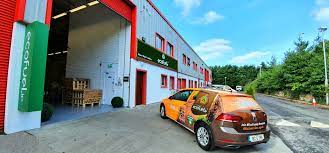To change up my work week, I have been hitting the road for the past few Saturdays, visiting stove showrooms to learn all about the latest in the stove industry while also sharing my knowledge on EcoBriquettes from running ECOFUEL™ for 10 years now.

It’s true.
The landscape, both environmental and customer expectations, is rapidly changing, but so is wood-burning stove technology. Modern wood burners offer dramatically improved efficiency and minimal emissions today, so I was eager and excited to learn more.
The first question I had.
Are wood-burning or, as some might call it, log burners still popular?

After spending a few Saturdays at the local Dublin and Galway stove showrooms, meeting and talking to the owners and, most importantly, speaking with the local visitors, my conclusion is yes.
Sure, there is a mix of what types of stoves people buy, from gas to pellet stoves, but from observing and speaking with the visitors, I have clear evidence that wood-burning stoves remain the most popular type of stove bought during my visits.
But why do people still buy them, especially when heat pumps are trending?
There are a few reasons.
First, a stove is never meant to be a primary energy source but a place of comfort and a focal point.
Sure, a stove with the correct fuel will warm your room and surrounding rooms, but you likely didn’t buy a wood-burning stove as your primary heating source.
The rest of the reasons why wood-burning stoves remain popular is evolution.
Humans and fire go back thousands of years.
Lighting a fire undeniably gives one a sense of accomplishment and satisfaction.
You might even pick up a trendy magazine only to see how a wood-burning stove remains a focal point of a modern living space.

Are you exhausted after a long and stressful day?
What better way to slow down and recharge than gazing into a genuine fire with a therapeutic element? No gimmicks can replace that!
Then, there is a technology part.
People who upgrade now get a better working stove.
The latest wood-burning stoves have Ecodesign technology, which meets the strictest air regulation standards in Ireland and the UK and can be legally fitted in low-smoke areas, even in the most urban parts of the country.
But how do the new Ecodesign stoves stack against the old generation's log burners?
One key difference between Ecodesign stoves and previous-generation stoves is the air intake and combustion optimisation. New Ecodesign log burners provide a steady heat output and produce an exceptionally clean burn, with 80% fewer emissions than traditional stoves and up to 90% less than an open fire.
But, there is this gap or unspoken fact.
The right type of fuel.

No stove will burn clean, hot, and efficiently with wet logs picked up from a local garage or poorly compressed briquettes with questionable raw material and high moisture content.
The answer?
Use Ready To Burn and EPA-registered hardwood logs with a low moisture content!
Whether your logs are seasoned or kiln-dried, ensure they have moisture below 20% of moisture content. Wet logs don’t burn clean and create unneeded smoke and air pollution.
Want to go further and unlock performance, plus a more sustainable option?
Invest in high-quality wood briquettes.
The EcoBriquettes will burn at a higher efficiency and produce higher heat output with less fuel consumption than kiln-dried hardwood.
The keywords are performance, and less is more, which I understand are two words that are hard to grasp, especially when all you have experienced is local forecourt fuels.

My final thoughts on the wood briquettes.
Wood briquettes vary in form and shape, so compare and test different briquettes.
The density, the raw material, and even the shape will determine the heat output and burning experience.
So, if you’re considering or even planning to invest in a modern, high-quality wood-burning stove, feel confident doing so.
My final advice is to buy your stove from a showroom that is also an expert in fitting and installation. This will ensure that you and your family have a memorable, trouble-free experience for the lifetime of your stove.
After all, the wood-burning stove is an investment, not an impulse purchase.
Thanks to the teams at Murphy Heating in Kinvara, Co Galway, Heatco in Rathfarnham, Dublin 14, and Robinson Fire & Stone in north Dublin for inviting me to their showrooms!
Further links and information on Ecodesign stoves and regulations.
Ecodesign for Sustainable Products Regulations. Link to article.
Ecodesign explained by Hetas. Link to article.
Ecodesign-compliant stoves from SEAI. Link to pdf.





